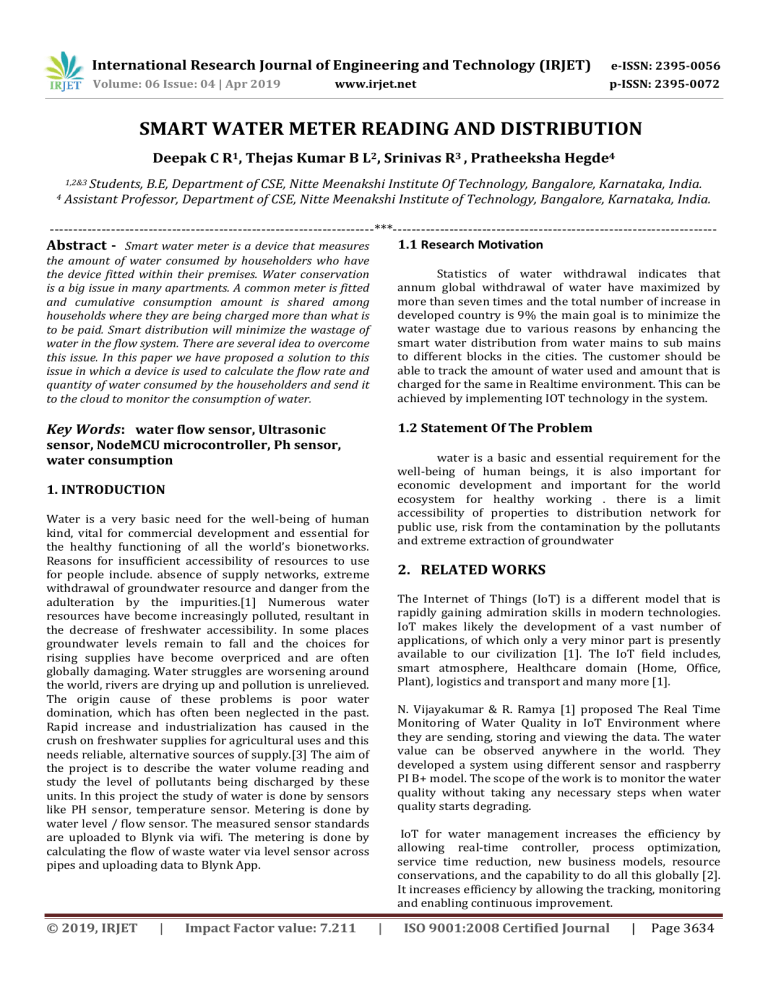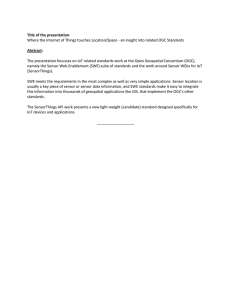IRJET- Smart Water Meter Reading and Distribution
advertisement

International Research Journal of Engineering and Technology (IRJET) e-ISSN: 2395-0056 Volume: 06 Issue: 04 | Apr 2019 p-ISSN: 2395-0072 www.irjet.net SMART WATER METER READING AND DISTRIBUTION Deepak C R1, Thejas Kumar B L2, Srinivas R3 , Pratheeksha Hegde4 1,2&3 Students, 4 B.E, Department of CSE, Nitte Meenakshi Institute Of Technology, Bangalore, Karnataka, India. Assistant Professor, Department of CSE, Nitte Meenakshi Institute of Technology, Bangalore, Karnataka, India. ---------------------------------------------------------------------***--------------------------------------------------------------------1.1 Research Motivation Abstract - Smart water meter is a device that measures the amount of water consumed by householders who have the device fitted within their premises. Water conservation is a big issue in many apartments. A common meter is fitted and cumulative consumption amount is shared among households where they are being charged more than what is to be paid. Smart distribution will minimize the wastage of water in the flow system. There are several idea to overcome this issue. In this paper we have proposed a solution to this issue in which a device is used to calculate the flow rate and quantity of water consumed by the householders and send it to the cloud to monitor the consumption of water. Statistics of water withdrawal indicates that annum global withdrawal of water have maximized by more than seven times and the total number of increase in developed country is 9% the main goal is to minimize the water wastage due to various reasons by enhancing the smart water distribution from water mains to sub mains to different blocks in the cities. The customer should be able to track the amount of water used and amount that is charged for the same in Realtime environment. This can be achieved by implementing IOT technology in the system. Key Words: water flow sensor, Ultrasonic 1.2 Statement Of The Problem sensor, NodeMCU microcontroller, Ph sensor, water consumption water is a basic and essential requirement for the well-being of human beings, it is also important for economic development and important for the world ecosystem for healthy working . there is a limit accessibility of properties to distribution network for public use, risk from the contamination by the pollutants and extreme extraction of groundwater 1. INTRODUCTION Water is a very basic need for the well-being of human kind, vital for commercial development and essential for the healthy functioning of all the world’s bionetworks. Reasons for insufficient accessibility of resources to use for people include. absence of supply networks, extreme withdrawal of groundwater resource and danger from the adulteration by the impurities.[1] Numerous water resources have become increasingly polluted, resultant in the decrease of freshwater accessibility. In some places groundwater levels remain to fall and the choices for rising supplies have become overpriced and are often globally damaging. Water struggles are worsening around the world, rivers are drying up and pollution is unrelieved. The origin cause of these problems is poor water domination, which has often been neglected in the past. Rapid increase and industrialization has caused in the crush on freshwater supplies for agricultural uses and this needs reliable, alternative sources of supply.[3] The aim of the project is to describe the water volume reading and study the level of pollutants being discharged by these units. In this project the study of water is done by sensors like PH sensor, temperature sensor. Metering is done by water level / flow sensor. The measured sensor standards are uploaded to Blynk via wifi. The metering is done by calculating the flow of waste water via level sensor across pipes and uploading data to Blynk App. © 2019, IRJET | Impact Factor value: 7.211 2. RELATED WORKS The Internet of Things (IoT) is a different model that is rapidly gaining admiration skills in modern technologies. IoT makes likely the development of a vast number of applications, of which only a very minor part is presently available to our civilization [1]. The IoT field includes, smart atmosphere, Healthcare domain (Home, Office, Plant), logistics and transport and many more [1]. N. Vijayakumar & R. Ramya [1] proposed The Real Time Monitoring of Water Quality in IoT Environment where they are sending, storing and viewing the data. The water value can be observed anywhere in the world. They developed a system using different sensor and raspberry PI B+ model. The scope of the work is to monitor the water quality without taking any necessary steps when water quality starts degrading. IoT for water management increases the efficiency by allowing real-time controller, process optimization, service time reduction, new business models, resource conservations, and the capability to do all this globally [2]. It increases efficiency by allowing the tracking, monitoring and enabling continuous improvement. | ISO 9001:2008 Certified Journal | Page 3634 International Research Journal of Engineering and Technology (IRJET) e-ISSN: 2395-0056 Volume: 06 Issue: 04 | Apr 2019 p-ISSN: 2395-0072 www.irjet.net Prachet Verma et al. [3] proposed IoT based water management system for a place where water circulation based on the water level in a tank across the place. The advanced system circulated enough water to each tank to satisfy local demands. Ultrasonic sensor has been used to know the water level in the tank. sensor detects the obstacle passing through the sub main pipes it automatically triggers the relay , then the valve is automatically turned off. 5) Ultrasonic Sensor It has Echo and Trigger, the Echo emits the Infrared beam then the reflected light is triggered and calculate the distance. Alessio Botta,, Valerio Persico, Antonio Pescape [4] provided the in-depth information of incorporation of Internet of things and cloud computing. They defined wide set of the application based on Cloud Computing and IoT like smart home, healthcare and smart metering, video surveillance , smart city and more. They explained the importance of cloud for IoT environment. 6) PH Sensor The Ph sensor is used to differentiate the liquid between Acid and Base . the main reason of using this sensor is to ensure the quality of the water. PROPOSED METHODOLOGY 7) Electric Valve In this paper we proposed the solution for water utilization using water flow sensor, ultrasonic sensor, IR sensor, Ph sensor, Temperature Sensor and interface with Node MCU microcontroller which embedded with Arduino code. Arduino software is used for Arduino coding to find flow rate of water, display the output in serial monitor and send the sensed data to the Android Application which can be monitored by customers. The electric valve is used to stop the water flow automatically if the obstacle is detected. 8) DS18B20 A) Hardware Needed The DS18B20 is a sensor that checks the temperature of the water and shows the real time analysis in the android application. 1) Node MCU ESP32 B) Software Used ESP32 is a sole 2.4 GHz Bluetooth and Wi-Fi composition chip intended with the TSMC extremist low power 40 nm technology. It is intended to accomplish the finest power and RF performance, viewing toughness, flexibility and dependability in an extensive variation of applications and power circumstances. Arduino IDE is used to generate the code and upload the code on microcontroller for Implementation and Testing. Blynk Android Application is used for real time monitoring purpose. 2) IR proximity sensor 1) Architectural Design C) DESIGN It is the Multipurpose IR Sensor is an add-on for a path follower robot and obstacles avoid robot that gives a robot the ability to detect line or near obstacle or elements. The sensor works by sensing reflected light emit from its own IR LED. 3) Water Flow Sensor The water flow sensor will calculate the amount of water used by the block. It contains the small valve that will rotate during the water flow , based on that the amount of water distributed is calculated. 4) Four Channel Relay Board (5V) Fig -1: Architectural Design It is a active low triggerd 4 Channel Relay Board that is used to control the valve in the system. Whenever the IR © 2019, IRJET | Impact Factor value: 7.211 | ISO 9001:2008 Certified Journal | Page 3635 International Research Journal of Engineering and Technology (IRJET) e-ISSN: 2395-0056 Volume: 06 Issue: 04 | Apr 2019 p-ISSN: 2395-0072 www.irjet.net All the sensors are the inputs for the node mcu controller. After processing the sensor values the output will be sent to an Android Application trough internet or Wi-Fi . [3] Verma, Prachet, Akshay Kumar, Nihesh Rathod, Pratik Jain, S. Mallikarjun, Renu Subramanian, Bharadwaj Amrutur, MS Mohan Kumar, and Rajesh Sundaresan, "Towards an IoT based water management system for a campus", In Smart Cities Conference (ISC2), 2015 IEEE First International, pp. 1-6. IEEE, 2015. 2) Activity Diagram [4] Botta, Alessio, Walter De Donato, Valerio Persico, and Antonio Pescapé, "On the integration of cloud computing and internet of things",In Future Internet of Things and Cloud (FiCloud), 2014 International Conference on, pp. 2330. IEEE, 2014. [5] Ghemawat, Sanjay, Howard Gobioff, and Shun-Tak Leung, "The Google file system", In ACM SIGOPS operating systems review, vol. 37, no. 5, pp. 29-43. ACM, 2003. Fig -2: Activity Diagram E) Experimental Analysis The Cloud based Android Blynk Application available in internet with which the data is sent to the cloud using WiFi and the users can monitor the output that is displayed in the form of graphical Representation. 3. CONCLUSIONS The high pollution load of effluents affects the water quality which in turn leads to significant environmental problems and health risks to the rural communities which rely directly on the water available in the nearby water bodies for domestic purposes without its treatment. Therefore, it is recommended that the effluents of textile industries must be treated well before their discharge into the surrounding water bodies. REFERENCES [1] Vijayakumar, N., and R. Ramya, "The material phase observing of water excellence in IoT environment", In Circuit, Power and Computing Technologies (ICCPCT), 2015 International Conference on, pp. 1-4. IEEE, 2015. [2] Robles, Tomás, Ramón Alcarria, Diego Martín, Augusto Morales, Mariano Navarro, Rodrigo Calero, Sofia Iglesias, and Manuel López, "An internet of things-based model for smart water management", In Advanced Information Networking and Applications Workshops (WAINA), 2014 28th International Conference on, pp. 821-826. IEEE, 2014. © 2019, IRJET | Impact Factor value: 7.211 | ISO 9001:2008 Certified Journal | Page 3636


